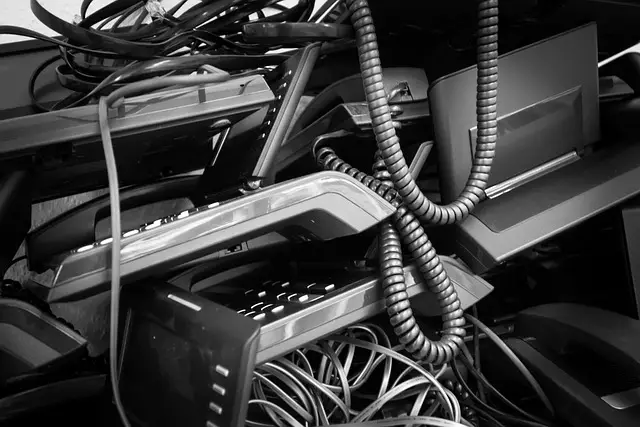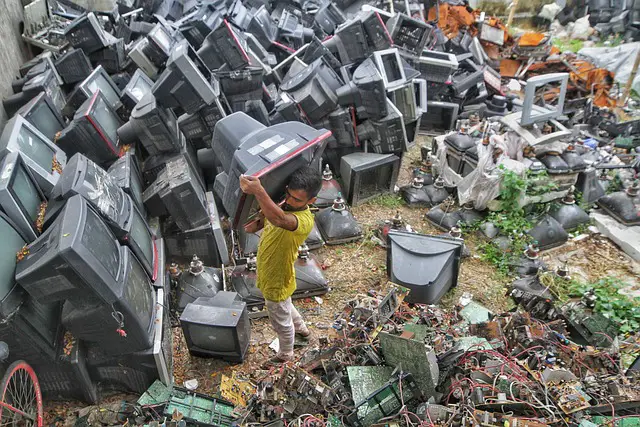Introduction
The global population is producing more waste than ever before, but few are aware of the environmental crisis that e-waste poses. E-waste, or electronic waste, is an increasingly pressing matter as technology continues to evolve at an exponential rate. As one of the fastest growing waste streams in the world, it’s time for us to really understand and address this problem.
From hazardous chemicals to health risks, e-waste has a range of negative impacts that we must work together to tackle. This essay will explore what e-waste is and why it is such an important issue, as well as examining its various impacts and a possible circular approach for electronics.

Related: What is e-waste?
What is e-waste?
E-waste, or electronic waste, is any discarded electrical or electronic device that is no longer in use. This includes computers and other IT equipment, smartphones and tablets, gaming consoles, TVs and monitors, electronic toys and appliances. It also covers items such as batteries and lamps that contain hazardous materials such as mercury.
E-waste can be anything from a single laptop to an entire office of outdated equipment. With the rapid advancement of technology, more and more people are discarding their old devices in favor of newer models – resulting in a huge amount of e-waste being produced every year. E-waste poses a real environmental threat and requires proper disposal to prevent pollution.
The six waste categories
E-waste is divided into six different categories, each of which can cause harm to the environment if not properly disposed of. The first category is hazardous waste, which includes items such as batteries and lamps that contain toxic materials like mercury or lead. This type of e-waste must be carefully handled in order to prevent contamination and pollution.
The second category is electronic components, such as circuit boards, chips, wires and other electronic parts that are very difficult to recycle. Waste from electronic appliances is the third category; this includes microwaves, TVs, computers and other large electrical items that require special measures when disposing of them.
The fourth category is plastic waste; many electronics include plastic components that must be recycled in order to reduce their environmental impact. Metals are the fifth category; these include copper, aluminum and steel which are often found in computers and other electronics. Finally, the sixth category is glass waste; this includes monitors, screens and various types of lenses that must all be recycled safely. By understanding these six categories of e-waste we can work towards a more sustainable future for our planet!
E-waste can be a serious hazard to our environment if not handled properly, but with proper research and understanding of the different categories of e-waste, we can make a difference in helping to protect our planet. As one of the fastest growing waste streams, it’s important that we stay informed and continue looking for better ways to recycle and dispose of e-waste safely.
E-waste as one of the fastest growing waste streams
E-waste is one of the fastest growing waste streams, and it poses a serious threat to our environment. As technological advancements continue to be made, more electronic devices are being discarded in landfills or burned to reduce their volume. This causes toxic materials such as lead, mercury and other pollutants to enter the atmosphere, leading to air and water pollution.
In addition, these hazardous materials can have long-term effects on human health. To help address this issue, governments and organizations have put in place various initiatives for proper handling of e-waste. These include collecting used electronics for reuse or recycling, providing incentives for companies that practice responsible disposal methods, encouraging consumers to donate or recycle their old electronic devices and educating people on the importance of proper e-waste management. By taking steps towards reducing our environmental impact from e-waste we can build a better future for ourselves and our planet.
E-waste is a growing concern, and it’s up to us to take the necessary steps to reduce our environmental footprint. Together, we can make sure that e-waste is properly managed so that future generations don’t have to face the negative impacts of our neglect. Now let’s explore how e-waste affects our environment and health.
Impacts of e-waste
E-waste has serious impacts on our environment and human health. The hazardous materials contained in electronic devices such as lead, mercury and other pollutants can enter the atmosphere when these items are burned or thrown into landfills. This causes air and water pollution, resulting in negative effects on our health. Long-term exposure to these materials can cause cancer, kidney damage, reproductive problems and birth defects. In addition, e-waste contains valuable resources such as metals that can be recycled for use in new products, reducing the need for mining and conserving natural resources.
To help address this issue, governments and organizations have put in place various initiatives for proper handling of e-waste. These include collecting used electronics for reuse or recycling, providing incentives for companies that practice responsible disposal methods, encouraging consumers to donate or recycle their old electronic devices and educating people on the importance of proper e-waste management. By taking steps towards reducing our environmental impact from e-waste we can build a better future for ourselves and our planet.
We must take responsibility for our e-waste and ensure that it is disposed of properly. If we do not, the toxic materials contained in these devices will continue to poison our planet and harm us. Make sure you join us next time as we explore the profound impacts e-waste has on human health.

Impacts on human health
The impacts of e-waste on human health are serious and far-reaching. Many electronic devices contain hazardous materials such as lead, mercury and other pollutants that can be released into the environment when these items are burned or thrown in landfills. This can result in air and water pollution, which can cause cancer, kidney damage, reproductive problems and birth defects with long-term exposure. Furthermore, improper handling of e-waste can also contaminate soil and groundwater with toxic materials, leading to further health issues.
It is imperative that we take steps to mitigate the effects of e-waste on our health. Governments and organizations have put in place various initiatives for proper disposal of electronics, including collection for reuse or recycling, providing incentives for companies practicing responsible methods, encouraging donations or recycling of old devices and educating people about the importance of proper e-waste management. By taking responsibility for our e-waste we can help protect ourselves from the damaging toxins contained within these products.
Environmental impacts
E-waste has a significant environmental impact. It is estimated that approximately 50 million metric tons of e-waste are generated annually, with only about 20 percent of this amount being recycled or reused. The rest is often illegally dumped in landfills and waterways, releasing toxic pollutants such as lead, mercury and cadmium into the environment. These pollutants can cause air and water pollution, leading to health problems for people and animals alike.
In addition, e-waste can have an effect on climate change due to its high energy consumption during production and disposal. It is also responsible for emitting greenhouse gases such as carbon dioxide into the atmosphere, which contributes to global warming.
We must take steps to reduce the environmental impacts of e-waste by encouraging reuse and recycling of old devices, increasing public awareness about the proper disposal of electronics, providing incentives for companies that practice responsible methods and investing in research on green technologies that can help reduce our reliance on non-renewable resources. By working together we can make a difference in protecting our planet from further damage caused by e-waste.
Circular Approach for Electronics
The circular approach for electronics is an innovative solution to the e-waste problem. It seeks to close the loop on the life cycle of electronic products and components by recovering, reusing, and recycling them in a sustainable manner. This approach helps reduce waste and promote sustainability by providing economic incentives for reuse and recycling.
It also encourages companies to design products that are easier to disassemble and recycle, reducing the environmental impact of manufacturing new products from scratch. Additionally, it helps reduce energy consumption during production, as well as emissions of greenhouse gases into the atmosphere. Finally, it supports local economies by creating jobs in the recycling industry and helping businesses save money on raw materials when they use recycled components.
In conclusion, the circular approach for electronics is an effective way to tackle e-waste while promoting sustainability. Circular approach closes the loop on the life cycle of electronic products, helping to reduce waste and protect our planet from further damage caused by e-waste. By encouraging reuse, recycling, and responsible product design, we can help protect our environment while also creating economic opportunities for individuals and businesses alike.
Related
- Trusted and safe methods of Electronic Waste Removal
- Importance of E-waste Management: Top Reasons Justifying Why it’s Crucial?
- How to Minimize Environmental Impact of Debris/ Construction Waste?
- Are we closer to Garbage Pandemic because of our failed waste management system?
- Importance of Liquid waste management
- Importance of Solid Waste management